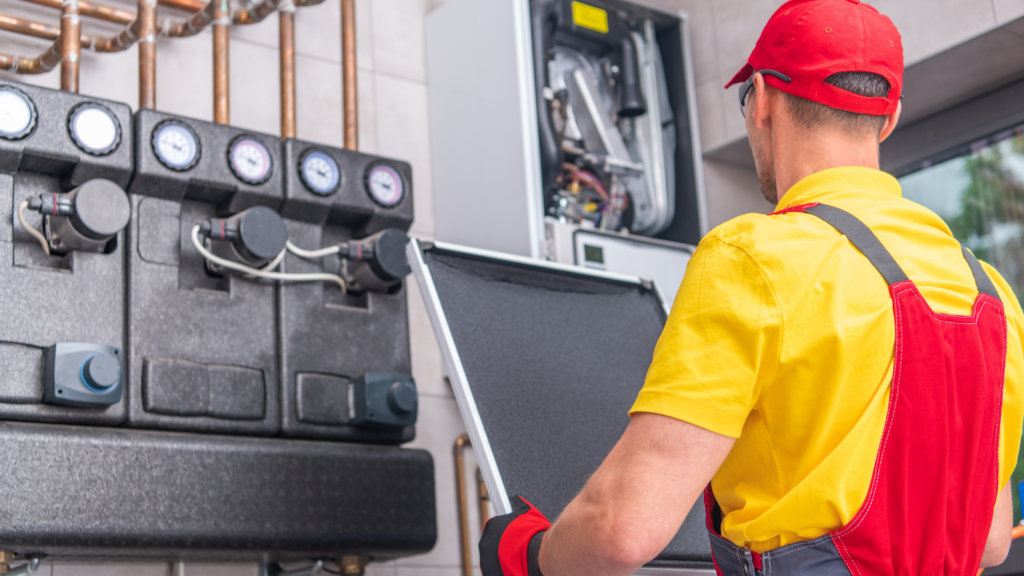Unlocking the Mystery: How Long Does a Furnace Last?
A furnace is more than a piece of household equipment; it’s the cornerstone of your home’s comfort during the cold seasons. As such, one of the key questions for homeowners is, “How long does a furnace last?” This query isn’t just about gauging the durability of a heating system. Understanding the furnace’s life expectancy is essential for several reasons.
First, knowing when you might need to replace your furnace allows for better budgeting and avoids the surprise of sudden breakdowns. Second, the efficiency of a furnace often declines over time, affecting both your heating costs and your home’s environmental footprint.
Being aware of your furnace’s lifespan helps in making timely decisions regarding maintenance or upgrades, ensuring your home remains comfortable, energy-efficient, and cost-effective.
Understanding Furnace Lifespan
A furnace is a device used for high-temperature heating. It’s the heart of your home’s heating system, converting fuel into heat to keep your living space warm. The functionality of a furnace involves drawing in cold air, cleaning it through an air filter, heating it with a gas or electric burner, and distributing the warm air throughout your home via ductwork.
Factors Influencing Lifespan
Several factors contribute to the lifespan of a furnace. These include the type of furnace, the quality of its installation, and how well it’s maintained. Regular maintenance, such as changing air filters and professional inspections, can significantly extend the furnace lifespan. Environmental conditions, usage patterns, and even the size of your home can also affect how long your furnace will last.
Average Lifespan of a Furnace
The average furnace lifespan typically ranges between 15 to 20 years, depending on factors such as maintenance, usage patterns, and the quality of the unit. Proper care, such as annual servicing and regular filter changes, is important for maximizing lifespan, potentially extending it beyond the typical range.
Signs of a Dying Furnace
A furnace on its way out often shows clear signs: frequent repairs, rising energy bills, uneven heating across rooms, unusual noises, and age. If your furnace hits the 15 to 20-year mark or starts acting up consistently, it’s likely time for a closer look.
Replacing an old furnace before it fails can save you from unexpected discomfort and higher costs. Newer models are more efficient, safer, and can significantly lower your heating expenses. Recognizing the warning signs early and acting on them ensures your home remains warm, safe, and efficient.
Extending Furnace Lifespan
Regular maintenance is essential to extend the furnace’s lifespan. Simple tasks like changing air filters regularly and scheduling annual inspections can help prevent breakdowns and ensure efficient operation. This includes tasks such as changing air filters, cleaning ducts, and scheduling professional inspections. Keeping your furnace well-maintained helps prevent unnecessary wear and tear and ensures it operates efficiently for years to come.
Upgrading and Modernizing
Beyond regular maintenance, upgrading components like the thermostat can improve efficiency and reduce wear on the furnace. Consider investing in a programmable thermostat for better heat management. Additionally, modernizing parts of the HVAC system, such as ductwork or insulation, can lessen the strain on your furnace, further extending its lifespan.
Types of Furnaces and Their Lifespan
Choosing the right type of furnace for your home not only impacts your comfort during the colder months but also affects long-term costs and maintenance needs. Different types of furnaces vary in how they generate heat, their energy efficiency, initial installation costs, and, importantly, their lifespan.
Gas Furnaces
Gas furnaces are among the most common types, with an average life expectancy of 15 to 20 years. Their longevity depends on regular maintenance, including cleaning and inspections. They’re known for their efficiency and effectiveness in colder climates.
Electric Furnaces
Electric furnaces tend to last longer, often between 20 to 30 years. They have fewer moving parts and don’t burn fuel, reducing their wear and tear. While their operational lifespan is longer, they might have higher operating costs in areas where electricity is expensive.
Oil Furnaces
Oil furnaces usually have a lifespan of 15 to 25 years. They require more maintenance, such as regular cleaning of the soot and debris that accumulates. Proper upkeep is crucial for their efficiency and longevity.
Geothermal Heat Pumps
Geothermal heat pumps, while not furnaces in the traditional sense, are worth mentioning for their heating capabilities. They have a remarkably long lifespan, with the heat pump itself lasting about 15 years and the underground loop system lasting up to 50 years. They offer significant energy savings and environmental benefits, making them an increasingly popular choice.
Environmental Impact on Furnace Longevity
The longevity of a furnace is significantly influenced by its operating environment, encompassing both the external climate and the quality of indoor air. Furnaces in regions with severe winters endure more stress due to increased demand, potentially shortening their lifespan compared to those in milder climates where the heating load is lighter.
Similarly, indoor air quality plays a crucial role; dust, pet dander, and other particulates can clog the system, reducing efficiency and leading to premature wear. Ensuring your furnace is correctly sized for your home and regularly maintained, including the use of high-quality air filters and keeping ducts clean, are vital steps in mitigating these environmental impacts and prolonging the life of your heating system.
Quality vs. Lifespan: Finding the Balance
Selecting the appropriate furnace for your home requires finding a balance between the quality and lifespan of the unit and its initial cost. This balance is crucial because it not only affects the comfort of your home but also has long-term implications for your financial and energy efficiency considerations.
Longevity vs. Initial Cost
When comparing longevity versus initial cost in choosing a furnace, the key is understanding the long-term value. A less expensive furnace might seem like a bargain at first but could lead to higher costs over time due to frequent repairs, replacements, and lower efficiency.
On the other hand, investing in a higher-priced, quality furnace often means longer service life and lower energy bills, offering better value over its lifespan. Essentially, prioritizing longevity can lead to significant savings and reliability, outweighing the initial cost difference.
DIY Maintenance Tips for Prolonging Lifespan
Regular inspections and cleaning, along with timely filter replacements, help ensure optimal performance and prevent costly repairs, ultimately prolonging the furnace’s longevity. Maintenance and timely repairs can help extend furnace lifespan, ensuring efficient heating for years to come. Check for signs of wear and tear, such as rust or corrosion, and ensure all components are functioning properly.
Clean dust and debris from the furnace and surrounding area, and replace furnace filters according to manufacturer recommendations. This helps prevent airflow restrictions and ensures optimal performance, ultimately prolonging the furnace’s lifespan.
Professional Maintenance: When to Call the Experts
Ideally, your furnace should be inspected by an HVAC contractor once a year. This regular maintenance ensures any potential problems are identified and resolved early, which can prevent significant malfunctions and extend your furnace’s operational life.
Warning Signs for Professional Intervention
Certain warning signs indicate the need for professional intervention. These include strange noises, inconsistent heating, and unusual odors coming from the furnace. If you notice any of these signs, it’s best to call a professional technician to diagnose and address the issue promptly.
Retrofitting and Upgrading: Maximizing Lifespan
Investing in retrofitting and upgrades can significantly extend the lifespan of your furnace. By modernizing components and adopting advanced features, you ensure optimal performance and longevity for your heating system. Simple measures like improving insulation or sealing ducts can reduce strain on the system, leading to improved performance and longevity of your new furnace.
Upgrading to programmable thermostats or installing smart HVAC systems allows for better control and optimization of energy usage, ultimately prolonging the lifespan of the furnace.
Planning for Furnace Replacement
When considering furnace replacement, it’s important to assess your current system’s condition and the expected lifespan of a new unit. Factors such as the size of your home and heating requirements should also be taken into account. Evaluate upfront costs, long-term savings, and available financing options to make an informed decision that aligns with your budget and financial goals.
Look for units with high AFUE (Annual Fuel Utilization Efficiency) ratings to maximize energy savings and reduce long-term operating costs. Investing in an energy-efficient furnace can lead to significant savings on utility bills over the lifespan of the system.
Conclusion
The lifespan of a furnace typically ranges between 15 to 30 years, influenced by factors like maintenance, type, and usage patterns. Proper care, such as regular inspections and filter changes, can extend this lifespan, ensuring your home remains warm and energy-efficient. Warning signs of an aging furnace include frequent repairs and uneven heating, indicating it may be time for an upgrade.
Homeowners can make their furnaces last longer and reduce costs and environmental impact by investing in regular maintenance and choosing energy-efficient models when replacing an old furnace. By taking these steps, you can ensure that your furnace provides reliable comfort through many cold seasons.








